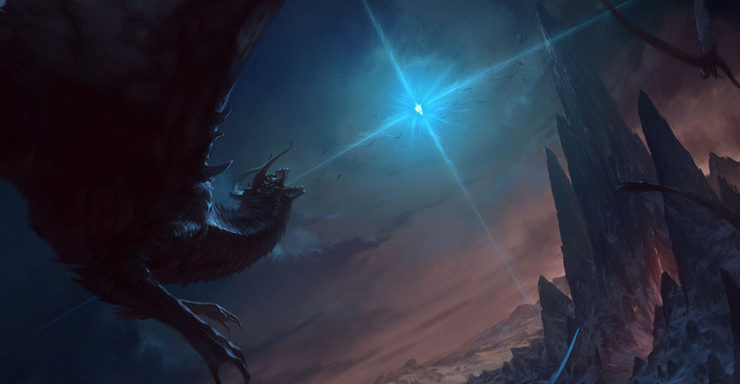In Which Morgoth Gets His Ass Handed To Him, the Last Sons of Fëanor Find Time To Make One More Bad Decision, and Beleriand Starts Taking On Water
Well, we’re down to it at last. The final showdown of the First Age, which gets less page space than any of the Wars of Beleriand—and yet it’s the greatest conflict of them all. We’ve not seen this sort of mayhem since the Valar mopped the floor with Morgoth back when his library card still read “Melkor.” And that was arguably a more discreet event, since the Valar were then trying to shelter the newly awakened Elves!
The second half of Chapter 24 is a bit like the rushed ending of a really great novel—something even the best authors can be guilty of. But it’s not the ending of The Silmarillion, just the Quenta Silmarillion, the history of the First Age which centers around the Noldor and those pesky Silmarils. So let’s get right into it.
Dramatis personæ of note:
- Eönwë – Maia, Manwë’s right-hand man
- Eärendil – Half-Elf, star-studded dragonslayer
- Maedhros – Noldo, tragic one-handed son of Fëanor (eldest)
- Maglor – Noldo, hapless two-handed son of Fëanor (next eldest)
- Morgoth – Ex-Vala, World’s Greatest Asshole
- Sauron – Maia, Assistant to the World’s Greatest Asshole
Of the Voyage of Eärendil and the War of Wrath, Part 2
When last we looked, Eärendil had taken to the heavens on his ship, Vingilot, and now he carries a Silmaril around the world as a new star. Taken together, the Eärendil + Silmaril combo is called Gil-Estel by the Elves, which means Star of High Hope. (Note: millennia from now, a two-year-old Aragorn will be given the name Estel while his lineage was kept secret “until the proper time.”)

But now, spurred to action by Eärendil’s great voyage, the Valar are going on crusade! Morgoth’s crossed too many red lines, and they’re pissed—wrathful, even, and probably have been for a long time. The polite and courageous request of one of Ilúvatar’s own children was all they needed to let slip the Valinorean hounds of war.
The host of the Valar is thus borne across Belegaer, the Great Sea, in ships lent to them, and manned by, the Teleri. Thus the Vanyar, some Noldor, and a whole lotta Maiar storm the beaches of Beleriand where Morgoth presumes to reign. Now, the Teleri doing the actual marine work refuse to set foot on shore; instead, they hang back on their ships. Which seems fair. They still hold a grudge against the rebellious Noldor for what they did, and will go no further in helping to liberate those who remain. Plus, they have another reason to be wary: those arsonistic sons of Fëanor might still be lurking about.

Now, it’s the Maiar and possibly some of the Valar who are the mysterious ones in this host, for we are told that they are now “arrayed in forms young and fair and terrible.” See, we know that only Ainur (i.e. Valar and Maiar) can alter their bodies and shapes in such ways. And the host of the Valar is not subtle, and so their forms are probably not small and Elven-soft. The mountains ring beneath their feet and all of Beleriand is “ablaze with the glory of their arms.” Wow. Are, like, a bunch of them assembling, Voltron-style, and advancing towards Angband like some great titan? Either way, I would so love to see the expressions on the faces of the first Orcs who caught sight of this host.
But what a wonderful invitation to imagine! Tolkien gives us very little to work with, in part because the chief storytellers of this time were the Elves of Beleriand, and they’re not at all involved in this war. They learn only after the fact about how things went down. So that means we as readers are left with questions like:
- Is Eönwë, “whose might in arms in surpassed by none in Arda,” some kind of giant-sized knight?
- Are there Maiar of Yavanna who march out like colossal animals? Some sort of Tolkien-style kaiju? That would be boss.
- How luminous and awesome would the elite of Varda, Lady of the Stars, be?
- Does Tulkas send a brute squad, like a gang of pro-wrestlers who favor brawn over brain in the field of combat? Or is he the brute squad?
- Is Oromë getting in on the action? There’s no way his hunters and hounds aren’t here. And who knows, maybe the spirit of Huan leads them once again!
- Are there other good spirits of fire here, counterparts to the Balrogs (like Arien, the maiden who took up the task of bearing the Sun on its celestial course)?
- What form would warriors of Vairë the Weaver take? How badass would they be with their nets and spears? Do Mandos’s servants dish out bardic recitations?
- Are there earth elemental-style Maiar who serve Aulë, or am I just unable to turn off my D&D sensibilities?
Buy the Book
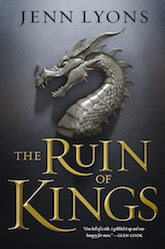

The Ruin of Kings
Whatever it really looks like, what follows is the War of Wrath—and because it’s covered so succinctly in the text, it’s easy to assume that it’s fast and fierce. But it’s more likely a long and protracted conflict. This is truly a war, not a battle. According to The War of the Jewels (vol XI of the History of Middle-earth) we learn that the host of the West reaches Beleriand in the year 545 of the First Age, yet the war doesn’t conclude until roughly forty-five years later. Now recall that these combatants are among the mightiest beings in the world…it’s no wonder Beleriand gets so torn up.
The Valar do not wage war lightly. They cannot afford to; the resultant devastation is much too great. Even if a representative of the Two Kindreds had gotten a hold of a Silmaril much earlier—like, say, before the fall of Nargothrond—and made it to Aman to entreat the Valar for aid, I don’t think they’d have taken action right away. At least, not like this. There were too many Elves and Men scattered about the lands then; too many towers and fortresses—too many communities. Too many lives of the Children of Ilúvatar at stake, and the Valar do not forget for whom Arda was made in the first place.
To say nothing of the devastation to the flora and fauna—possibly some mass extinctions—which are sure to follow. How bummed must Yavanna be about what’s coming? Although she always wanted to go after Morgoth, the natural world has really flourished since the rising of the Sun. I’m betting she’s the last of the Valar to consent to this Great War.
Morgoth responds with a terrifyingly large force of his own. It’s a bit ironic, actually. He himself is the physically weakest he’s ever been, since he’s spent so much of his Vala-born power in marring the world and inflating his monsters. Yet because he has done so, and because he’s been uncontested for decades now, his armies have never been stronger. Just how numerous have they become? Well, beyond count:
There was marshalled the whole power of the Throne of Morgoth, and it had become great beyond count, so that Anfauglith could not contain it; and all the North was aflame with war.
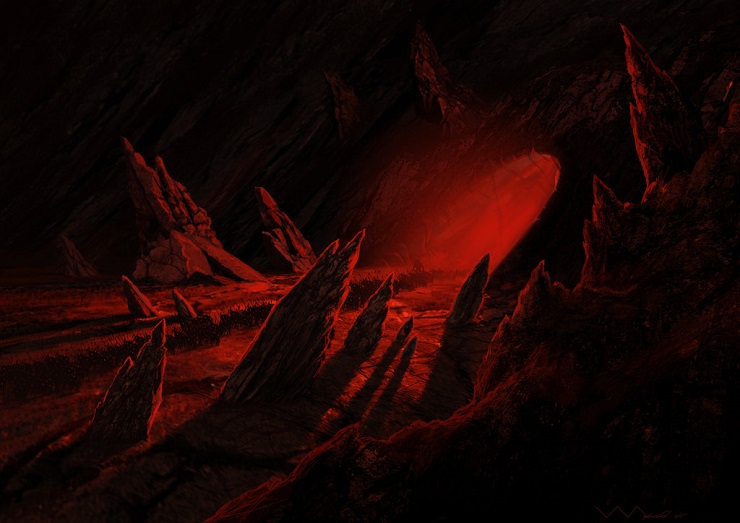
See that? The vast plain of Gasping Dust, where the Nirnaeth Arnoediad was principally fought, isn’t a big enough field to even temporarily hold his forces. How deep Angband is—or how vast the tunnels beneath the Iron Mountains must be—that his Orcs and wolves and werewolves and vampires and trolls and Balrogs can’t even fit onto his very prodigious front lawn! These forces have only multiplied, it seems, since he took over the North. So we’re talking huge armies, even more massive than those involved in the Battle of Unnumbered Tears or the Battle of Sudden Flame.
But now the skies resound with the trumpets of Eönwë, who, as the herald of Manwë and the master of arms, is essentially the general of this invading force. He likely has his own kick-ass marching band wherein seventy-six trumpets lead the big parade way and, I guess, Valinorean-style sousaphones brings up the rear? Followed then by a host of warriors.
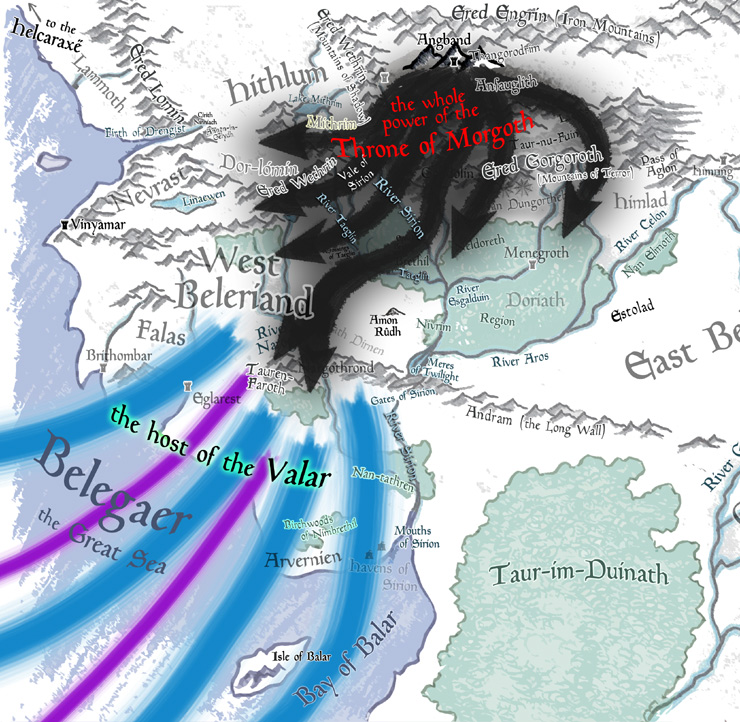
You know who’s not in this war? The Elves of Middle-earth, which includes the Noldor, the scattered Sindar, or even the Green-elves of Ossiriand. Not a one. Cowed by all their defeats, they’re sitting this one out. Also not taking any official part in this war are the Dwarves of the Blue Mountains (though they will be impacted, as we’ll see soon).
But guess who does join up with the host of the Valar? Men! You know, those measly Secondborn Children of Ilúvatar: the Sickly, the Usurpers, the Strangers, the Followers. To be fair, we’re talking about only the last remnants of the Edain, the three houses of Elf-friends (Bëor, Hador, and Haleth). But still, good on them! Their valor has always been lauded. And anyway, at this point, what have they got to lose? Their lives? Death is an escape from the hurts of the world, and from Morgoth’s reach.
That said, Easterlings join in the fighting as well, and they’re backing the very wrong horse. We’re talking about the people of Uldor (son of the treacherous Ulfast), who may or may not include the Easterlings that were “rewarded” with the occupation of Hithlum. But also other Men from east of the Blue Mountains come streaming over, likewise siding with Morgoth, “and the Elves do not forget it.”
Now, this clash of armies is so colossal and epic that we get…welp, pretty much nothing. Except for the bottom line, which doesn’t look good for Morgoth. Again, try and remember this isn’t just some skirmish on a bigger scale; it stretches on for years—decades!—no doubt involving prolonged campaigns, risky strategies, and setbacks on both sides. Think the Crusades meets World War I…and II, for that matter.
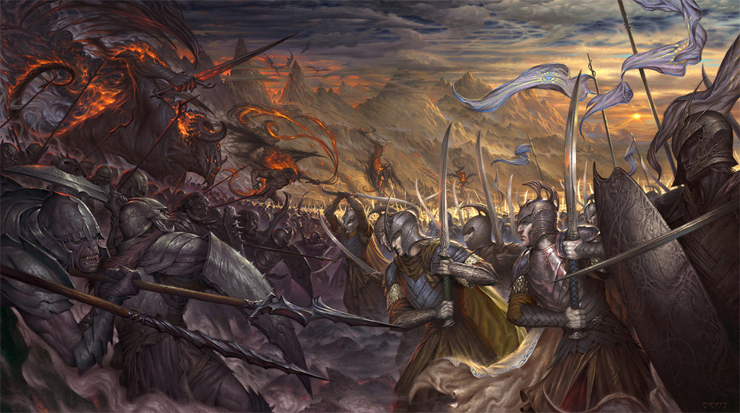
So how do Morgoth’s armies fare? Well, we’ve never seen his armies so deliciously defeated as described in this prose:
The Balrogs were destroyed, save some few that fled and hid themselves in caves inaccessible at the roots of the earth; and the uncounted legions of the Orcs perished like straw in a great fire, or were swept like shrivelled leaves before a burning wind.
Ohhhh snap!
So, all right, a trifling number of Balrogs seem to have gotten away, but they’ve gone underground now—but not back into Angband, instead finding super-deep places to hide out. As long as no one delves too greedily and too deep elsewhere in Middle-earth, I don’t think anyone needs to worry about these guys again. And the Orcs? They’re donezo, at least for a good long time.
At this point, Morgoth is given pause. He sees the Tengwar writing on the wall. The Valar are coming for him at last; it turns out Manwë wasn’t just going to let the depredations of half a millennium slide. Back in the days of Utumno, Morgoth was a force to be reckoned with. He was not so diminished from his Ainulindalë days, when he was “clad in ice and crowned with smoke and fire,” and it took the combined efforts of the Valar to simply apprehend him.
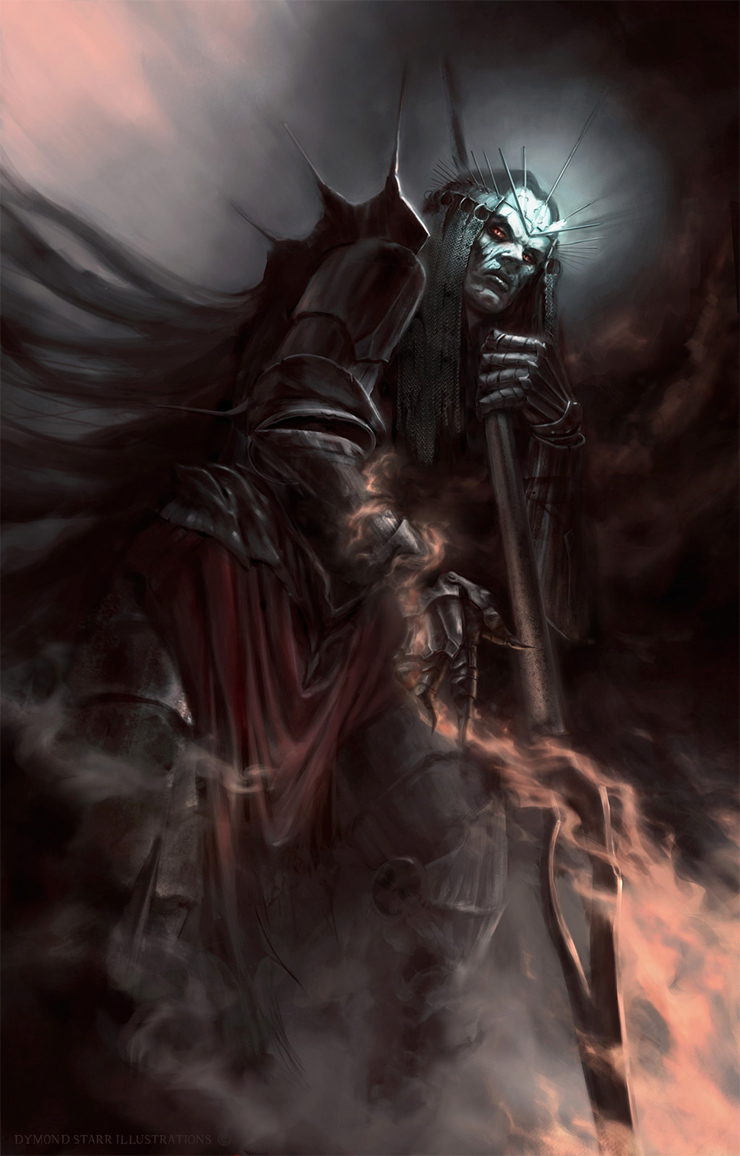
But now? No way can he stand up to Eönwë and his lionhearted forces in the flesh. Therefore he plays his final card, hoping it’s a real ace in the hole. If by “hole” we mean the voluminous pits of Angband, and by “ace” we mean dragons. Winged goddamn dragons! Fresh out of Morgoth’s R&D.
So off these flying fire-drakes go, to take on the host of the Valar.
Now, I do admittedly have a couple of questions myself: Were these winged dragons field-tested in the Iron Mountains first, or did they somehow have sufficient flyspace in deep caverns? And what harm would it have been to release the flying dragons earlier? Maybe they’re too testy, and too hungry. Maybe they’d eat and burn up too many Orcs if both forces were loosed in tandem? Maybe the dragons aren’t necessarily as loyal as their old granddaddy, Glaurung, had been?
See, even if Gondolin had lasted for some years more, once the Dark Lord got these winged dragons out and about, they’d have spotted the Hidden City in no time. Eagles be damned. Still, Morgoth’s dragon gambit in the War of Wrath pays off for a while.
…and so sudden and ruinous was the onset of that dreadful fleet that the host of the Valar was driven back, for the coming of the dragons was with great thunder, and lightning, and a tempest of fire.
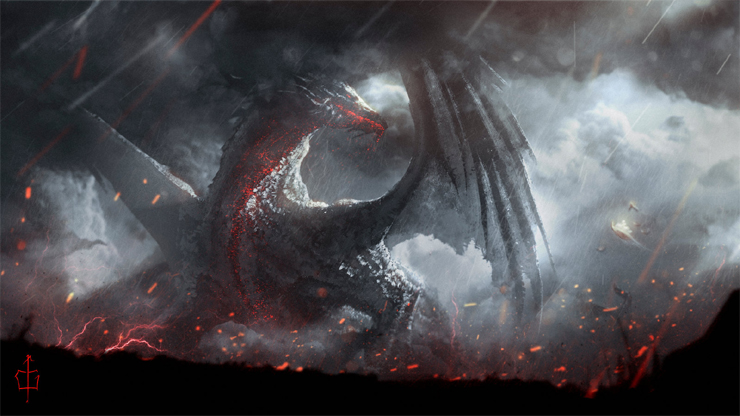
For some perspective on this: Remember when it was just Glaurung and a few of his wingless runts? Even Calaquendi Elves couldn’t withstand him! Only the Aulë-wrought Dwarves with their hardy skins and hardier battle masks were able to square off against them. But this new batch? There’s a freakin’ fleet now, and they’re all flying. The invading host can’t stave these fire-drakes off completely. Sure, no doubt plenty of Maiar can face their mettle, but dragons are the work of Arda’s formerly most powerful dweller. Morgoth himself might be much weaker than he was in his heyday, but his monsters are jacked up.
We’re also introduced oh-so-briefly to the mightiest of these dragons and probably the physically largest: Ancalagon the Black! We really only get this one moment with him, sadly, but he must feature into some stories that get passed down through the ages, since Gandalf brings him up like he’s a household name when telling Frodo about how the One Ring is impervious even to dragon-fire. Not even Ancalagon the Black, the wizard points out, would have been able to destroy this ring! So this drake’s breath must be truly toasty.
Anyway, these dragons might account for some of the years that go by, while the host of the Valar contend with them. They’re Morgoth’s big guns. But eventually the armies of the West do rally and retaliate, and more important, they finally get some air support.
Support, you might say, unlooked for that cometh at unawares!
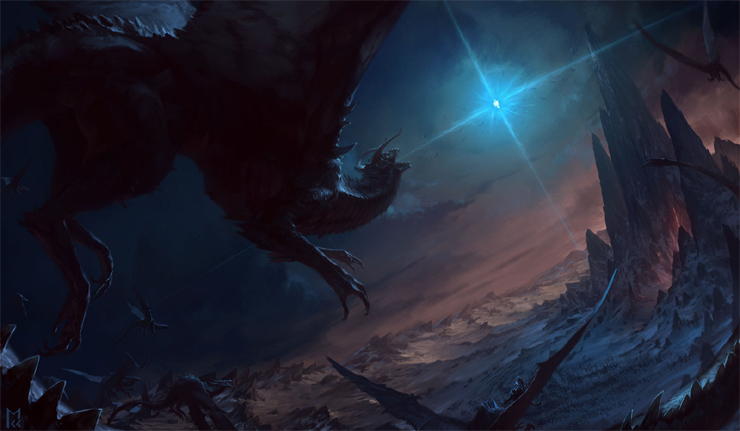
Because this is when Eärendil the mariner swooshes in, apparently taking a break from circumnavigating the world outside the Door of Night. From the deck of a white-gleaming, star-blazing Vingilot, he flies down into the fray but never touches down: Eärendil honors Manwë’s ruling that he cannot return to Middle-earth. Floating above it is a convenient loophole, (though rules-lawyer Mandos must surely disapprove).
Accompanying Eärendil are “all the birds of heaven”—that is, all of Manwë’s special ops. That’s right, the Eagles are coming! Of course, they’re led by none other than old Thirty-Fathom Thorondor, who we may all remember from such marrings as Morgoth’s face and such Elf-corpse retrievals as Fingolfin’s and Glorfindel’s.
And as the Eagles take on the dragons (feathers vs. leathers!), we’re given a solid measure of time, as the whirling and battling of these combatants lasts for a single “day and a night of doubt.”
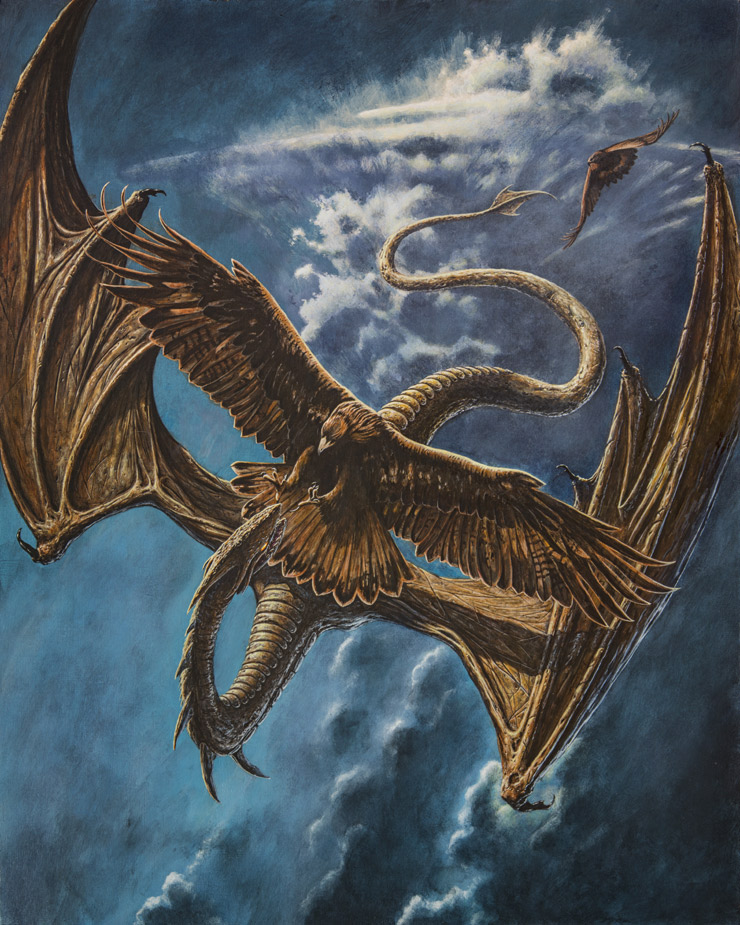
It culminates just before the rising of the Sun the next morning. Normally this is when folks would see the morning star in the sky—but right now it’s beaming out from Eärendil’s brow, and he’s way too busy battling the greatest dragon ever, thank you very much.
Eärendil does prevail, slaying Ancalagon the Black. We’re not sure how—it really doesn’t matter, as any detailed description of this amazing battle could fall short of its mythic power—but I have to think our hero is clad in the chainmail armor and rune-scored shield mentioned in Bilbo’s song. His dragon-horn bow launches arrows of ebony, his “sword of steel” is valiant, and let’s not forget the Silmaril strapped to his head which is sure to boost his every attack and damage roll against creatures of Morgoth.
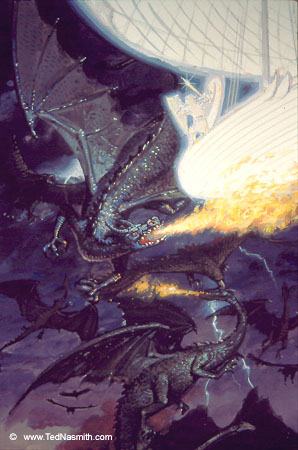
Anyway…
Ancalagon is eventually thrown down from the sky, right on top of the ginormous, slag-based baking soda volcano that Morgoth named Thangorodrim. These three monstrous peaks have endured as the metonymic symbol of the Dark Lord’s menace for a loooong time. They were the very towers of dread that Fëanor himself looked upon in his dying moments only to realize that the full might of the Noldor would never overcome them. But now, by the initiative of the Valar, the hope of the West, and the mariner most renowned, a very large dragon has been cast upon these towers and they break under the force.
Most of the dragons are slain, but of course, some do live on to breed another day. I mean, some future mama dragon is going to have to birth baby Smaug someday, right? The Lonely Mountain and the vast treasures of Erebor aren’t going to conquer themselves in the Third Age!
So this just leaves the head honcho himself. The Big Cheese of Evil. The OG Dark Lord.
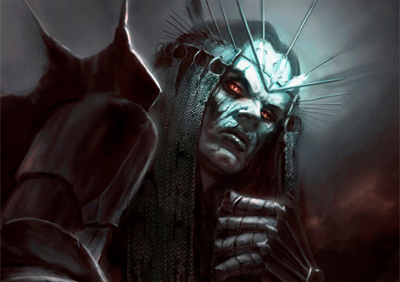
Eönwë and his host overtake the now unguarded Angband, unbattening all the hatches and tearing off its roofs. Pits are exposed and all monstrous guardians (if there are even any left) are routed and slain. Morgoth himself is now cornered in his dungeons, defeated. The text tells us “the might of the Valar descended into the deeps of the earth,” which to me really does imply that at least some of the Valar themselves are here—as they were the last time they came down and ripped the black sheep of the Valar out of his hidey-hole.
Like a bully who’s finally been stood up to, Morgoth abases himself, asking for “peace and pardon.” Like, hey, I was only kidding! Can’t you all take a joke? Well, his feet are “hewed from under him,” so he’s laid low by warriors probably smaller than he—likely some valiant Vanyar or Noldor. Then he’s thrown down right onto his freakin’ face, and…I’m sorry, but I have to think Tulkas is on the scene for this. He’s been dreaming of this moment for a long time, no question. Morgoth is no match for him—not even close, especially now that he’s squandered so much of his strength in polluting the world.
In the very least, I like to think there are a series of punches from Tulkas the Strong. “This [*punch*] is for Telperion, and this [*punch*] is for Laurelin. This [*punch*] is for Finwë, and [*punch*] Fingolfin, and this [*punch*] is for stringing along Fëanor and ruining him, and this [*punch*] is for the way you looked at Nessa that one time, and maybe this [*punch*] for ogling Lúthien. And this [*punch*] is for…” The list in my head is long but distinguished.
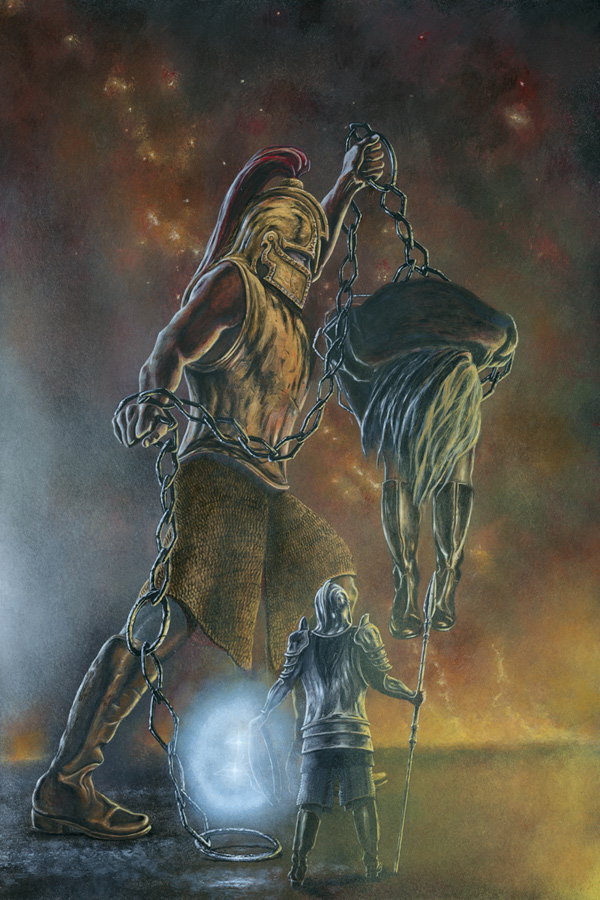
At some point, out comes Angainor, that big chain he wore once back in the day, when the Valar had some shred of patience for him yet.
and his iron crown they beat into a collar for his neck, and his head was bowed upon his knees.
Such an evocative image, and such a symbolic one! So you’re King of the World, eh? Nice crown you got there, asshole; but we think it would look better around your traitorous neck! Yes, of course, all the Valar are too classy to say anything like that (but Tulkas is definitely thinkin’ it). Given that Aulë himself had fashioned the chain Angainor, I wonder if he or at least some of his Maiar are the ones to repurpose Morgoth’s crown and hammer it into its new form, probably right there in the sub-basement of Angband. Bonus points if Angband is now so thoroughly ruined that the Sun comes beaming down on him, just to add further injury.
Either way, Morgoth is then dragged away. But we haven’t quite seen the last of him. Sit tight.
What’s also really cool, but very easy to overlook, is the fact that at this point “a multitude of slaves” is released from Morgoth’s prisons. We’ve seen this sort of thing before, such as when Lúthien freed the slaves at Tol-in-Gaurhoth, Sauron’s Isle of Werewolves. But this is Angband and the numbers are much greater. This motherlode of ex-captives could be a whole bunch of Noldor, Sindar, and Men of all stripes who have heretofore been unaccounted for—and therefore might well represent more of the people, or the ancestors of the people, who live on in future ages.
And at long last, after some six hundred years or so, the Silmarils are reclaimed! Well, two of them. That third one is still stuck to Eärendil’s head, and it’s going to keep on encircling the world with him till the world is remade. So Eönwë takes charge of these two jewels of Fëanor, and he sets a guard on them in his camp until such time as they’re shipped back to Valinor. There are many possibilities for the Silmarils now. They can be placed somewhere for all to view and enjoy, or maybe—just maybe—they Valar will find a way (sans Fëanor) to “unlock” them and allow Yavanna to rekindle the Two Trees or something amazeballs like that.
But we need to talk about the destruction of Beleriand and its realms, which has been hinted at and voiced more than a few times throughout the book. By the time of the final confrontation with Morgoth, the land had already begun to change. To…well…sink.
For so great was the fury of those adversaries that the northern regions of the western world were rent asunder, and the sea roared in through many chasms, and there was confusion and great noise; and rivers perished or found new paths, and the valleys were upheaved and the hills trod down; and Sirion was no more.
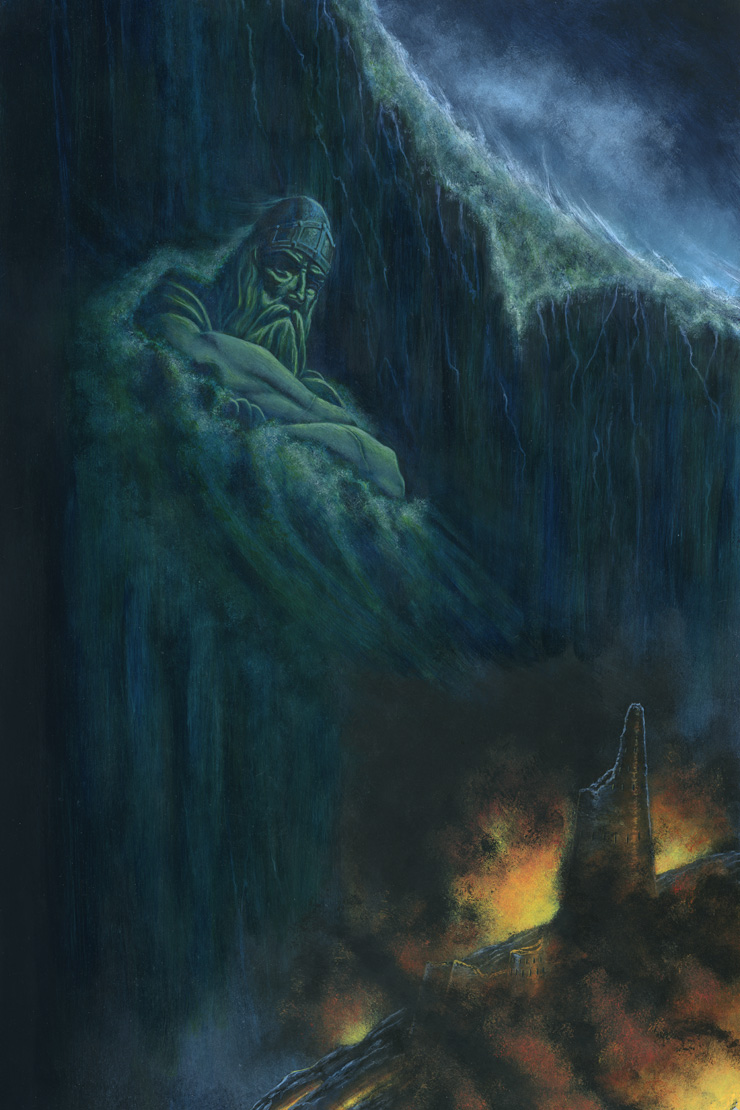
So, two things about this.
One, “so great was the fury of those adversaries” sure sounds like some actual Valar were battling Morgoth’s forces in person (though no, it’s not definitive, and it’s likely not all of them). Recall that when the Valar had punched their way into Morgoth’s old fortress of Utumno thousands of years ago, they rocked the land dramatically enough that the Elves at Cuiviénen felt it in the earth beneath them and heard the clamor from afar. The Great Sea expanded, pushing Aman and Middle-earth further apart. Yet even back then the Valar hadn’t wrecked as massive a piece of the continent as they have now in the War of Wrath. Maiar can be mighty, but this feels like the combined firepower of some heavy-handed Valar as well.
Two, the sinking of Beleriand isn’t happening overnight. Though most of it will fall under the waves entirely, it takes time for the rivers and seas to wash over the land. It’s not like the slaves freed in Angband come walking out and find themselves scrambling for lifeboats. Beleriand’s changing, but it’s not gone yet. And in the events that follow below, there is obviously still some land left to walk around on for a while. But I do think it’s safe to say that all Elves and Men are forced to shuffle around—or more likely, be shuffled around by Valinorean ushers—during this time. This chapter is so concise that we have to connect some dots ourselves.
Oh, wait. Here’s a third thing that no one really talks about. Going back to that passage…
and Sirion was no more.
Yes, this is all a great calamity to many—Ainur, immortals, and mortals alike—watching Beleriand swallowed up like this. I can’t help but think that Aulë and Yavanna would find the loss especially sorrowful. Aulë was aggrieved the last time the Vala battled Melkor, knowing how much it would harm the earth. And now? All those wonderful mountains and caves and valleys and tors and ravines and hills…they’re all just collapsing and going under. And Yavanna! She has so many of her creatures living in these lands, innumerable plants and animals—possibly whole species!—surely wiped out. The Ents, as we learn from Treebeard later, have moved eastward, at least.
But see, Sirion itself gets called out in the text where other rivers do not. We know Ulmo must be bummed. This was his favorite river! (With Gelion a close second.) The mighty Sirion was his buddy; through it he had aided the folks of Beleriand quite a few times: Turgon, Finrod, Húrin, Tuor, and on. Yes, water is water, and it all drains back to his oceans. But rivers, like all natural things, have an identity to the Valar…and to Tolkien. A moment of silence, then, for the drowned River Sirion.
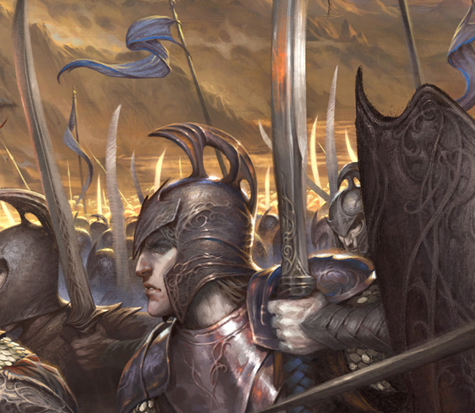
In the meantime, Eönwë is still in charge of what’s going on in Middle-earth. If any of the Valar had come out for the fighting, they’ve probably retreated now, steering clear of Middle-earth as much as possible for their own overarching reasons. And so it falls to Manwë’s agent to issue a new summons to the Elves of [the currently sinking] Beleriand: they can, perhaps even should, now depart from Middle-earth and go to Valinor. The time of the Elves is already waning anyway, and had been since the rising of the Sun.
But think of this as a soft summons, because the Firstborn are not so much ordered out of Middle-earth as shown the door. It’s a door, we will see for at least two long ages more, that will stay open and be manned by Círdan the Shipwright. But it’s only for Elves. Remember that. There will be a quiz.
Meanwhile, Maedhros and Maglor have found themselves in a truly sticky situation. Eönwë has the Silmarils, and he’s right here! And by their Oath, the must now go after him. They deliberate and grieve over it; neither of them actually wants to do it. Are there any loopholes they can exploit? Not really. And rather than going up to Eönwë himself in person, they send messengers to his camp as part of their ask-nicely-for-the-Silmarils-first policy.
Eönwë simply responds that NO, the Silmarils are not his to yield. Essentially, they’re exhibits A and B in the custody of the court of Valinor. Furthermore, his messengers respond, the sons of Fëanor have lost all rights to the Silmarils anyway. They might have had a legitimate claim before, but that’s all gone now, especially after all the horrendous things they’ve done in their name. The Silmarils are now set to return to Valinor, where they were made. Oh, and also: Maedhros and Maglor are hereby ordered to appear in Valinor and face the judgement of the Valar. The last remaining sons of Fëanor have been subpoenaed.
So here’s a question some might have in regards to the M-brothers, but could also be applied to other circumstances (such as Eärendil’s quest earlier in this chapter). The question is, why is there a need to go all the way to Valinor to ask for pardon or to face judgement? Why couldn’t Eärendil (or others) merely stand on the shores of Middle-earth and supplicate the gods from afar? Surely Manwë and Varda can see and hear.
And for Maedhros and Maglor in their situation, couldn’t Manwë have just handed out a judgement right here in Beleriand? Or might this be proof that that the Valar didn’t appear in the War of Wrath? Why would Eönwë direct the sons of Fëanor to first travel all the way back to Valinor in Manwë was already here? Can’t he just point and say “take it up with the big guy”? Well, for one, even if some of his brethren did come, Manwë himself almost certainly didn’t leave his halls atop Taniquetil, the Holy Mountain.
Tolkien addresses this sort of thing in Morgoth’s Ring (vol X of the History of Middle-earth):
He, like Melkor, practically never is seen or heard of outside or far away from his own halls and permanent residence. Why is this? For no very profound reason. The Government is always in Whitehall. King Arthur is usually in Camelot or Caerleon, and news and adventures come there and arise there. . . . Even to the final war against Morgoth it is [Eönwë] who leads out the power of the Valar. When we move out Manwë it will be the last battle, and the end of the World (or of ‘Arda Marred’) as the Eldar would say.
Simply put, that’s not how it is done in the great tales. To put it yet another way, here are similar words from Tolkien’s friend, C.S. Lewis, who in his book Mere Christianity could just as well be speaking of Manwë or Ilúvatar himself:
But I wonder whether people who ask God to interfere openly and directly in our world quite realise what it will be like when He does. When that happens, it is the end of the world. When the author walks on to the stage the play is over.
With this in mind, let’s return to the sons of Fëanor. Maglor tries to convince his big brother to just lay their Oath aside and trust the mercy of the Valar. Maybe Manwë and Varda, being King and Queen of all Arda, can straight-up void it for them? At least, he suggests, maybe they can let it rest for a while. The Oath never said they couldn’t procrastinate, and they’ve certainly done it before. But apparently their daddy issues win out, as does their fear of the cosmic power that Fëanor had invoked in making the Oath in the first place.
And so one last lamentable decision is made, and yet they know they’re in the wrong. The two brothers sneak into Eönwë’s camp, find the Silmaril’s guards, and slay them. Presumably these guards are other Elves, as even the sons of Fëanor would be no match for a couple of guardian Maiar. Then they flee, Silmarils in hand—each brother carries one. Holding the hallowed gems, it becomes clear that Eönwë was right: their claim to the Silmarils isn’t legit, for their “hands unclean” are scorched by them! Although the camp is roused at this murder and theft, Eönwë forbids pursuit. Maedhros and Maglor have made their decision and dug their own graves. Free will can be a bitch.
Maedhros suffers “pain unbearable” with his one hand. Remember, the other one was cut off on Thangorodrim long ago in a different time, back when he was trying to fight the good fight. And so great is his agony and despair that he finds a “gaping chasm filled with fire”…

…which, with Beleriand crumbling apart, is probably not as hard to find as it used to be.
He throws himself down with the Silmaril…
That’s right. Here we are at the end of an age, and a mighty objet d’art falls along with its bearer into a fiery crack of doom. Sure, sure, Maedhros had once hung in torment, facing certain death, from the side of a mountain of terror and against all hope made it back alive. Alas, there’s no coming back from this one. If you don’t believe me, ask Gollum.
Now Maglor, having just lost his big brother, is no less tormented by his burden. He is, after all, the most self-flagellating of the sons of Fëanor. He knows he deserves punishment. But instead of throwing himself into a pit to his death, he simply runs up to the edge of the land and casts the Silmaril into the Sea. Good riddance!
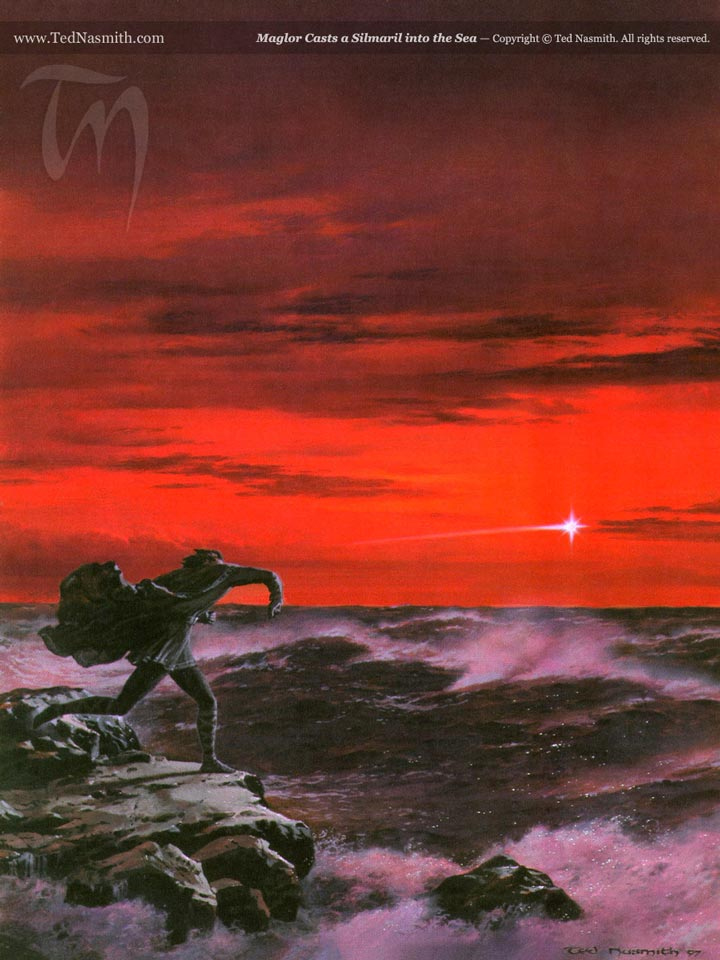
And then he wanders forevermore along the shores. We’re not told which sea—probably Belegaer, which ever encroaches upon the sinking Beleriand, but in theory it could be somewhere else in Middle-earth. Maglor, the minstrel who once composed a song about the Kinslaying he participated in—and goes down in history as the second greatest singer of them all—is never heard from again. He sings “in pain and regret beside the waves,” and that’s that. He never comes back among Elves ever again, so he appears in no more tales.
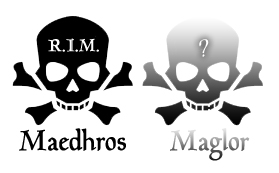
Thus one Silmaril lies buried somewhere deep in the earth. One has fallen into deep waters. And one rides above the atmosphere with Eärendil and Vingilot. So at least one of three is enjoyed by all from afar, while the people of Valinor are denied those glowing remnants of the Two Trees they adored.
We’re told that most of the Eldar do answer the summons of Eönwë and sail into the West. All the Vanyar go back, of course, but with them go most of what’s left of the Noldor and Sindar—those who fled from the havens of Sirion or were set free from Angband.
They were admitted again to the love of Manwë and the pardon of the Valar; and the Teleri forgave their ancient grief, and the curse was laid to rest.
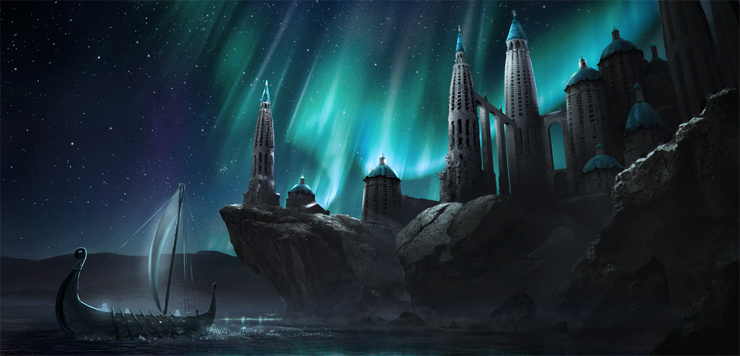
Woo! No more Curse of Mandos! And everyone is friends again. The reunions must be joyous indeed, and who knows which of the slain Elves of Beleriand have yet been released and re-embodied from the Halls of Mandos by this point? Whatever sorrows they had known may yet be soothed. And all of them get to know Nienna. Way back in the Valaquenta, we were told that…
all those who wait in Mandos cry to her, for she brings strength to the spirit and turns sorrow to wisdom.
At this point, that’s most of the royals of the Noldor who’ve gone to the other side.
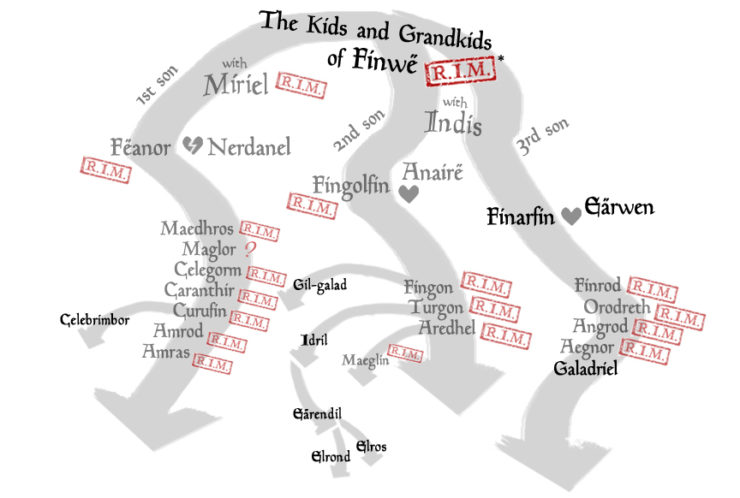
Now, who among the Eldar isn’t leaving Middle-earth? Well, an uncertain but relatively small number of Noldor (from whom Elves like Gildor likely stem) and some Sindar (from whom Elves like Thranduil of Mirkwood definitely hail). But also these folks, specifically, will be sticking around:
- Galadriel, the last of the Noldorin leaders who staged that famous walkout in Valinor
- Gil-galad, the last High King of the Noldor
- Celeborn, kinsman of Thingol and husband of Galadriel
- Celebrimbor, son of Curufin (and thus the grandson of Fëanor), who’s surely itching to get back into arts and crafts
- Círdan the Shipwright, the ever-faithful coast-dweller
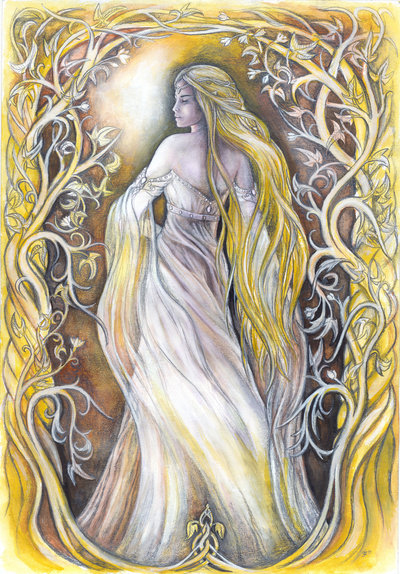
And of course, Elrond and Elros Half-elven. We’ll be coming back to them in the last two chapters of this book. But for now it’s important to know that from these brothers, the blood of the Elves “and a strain of the spirits divine that were before Arda” live on. That is: Great-great Grandma Melian the Maia’s blood is in that mix along with the blood of all three kindreds of the Eldar and the three houses of the Edain. And oh yeah, their dad continues to circle the world with a star on his head.
So by the endpoint of the chapter—and in preparation for the next one—Beleriand has largely crumbled away, and the Great Sea has swallowed it. So what does remain? Well, a whole swath of Ossiriand survives and forms the new western coastline of Middle-earth, but all its signature rivers have vanished. That entire region is renamed Lindon. The Blue Mountains also pull through, though they’re sundered into two halves by the Gulf of Lune (often spelled Lhûn). At the far eastern end of the gulf is the future site of the little port city of Mithlond—better known as the Grey Havens!
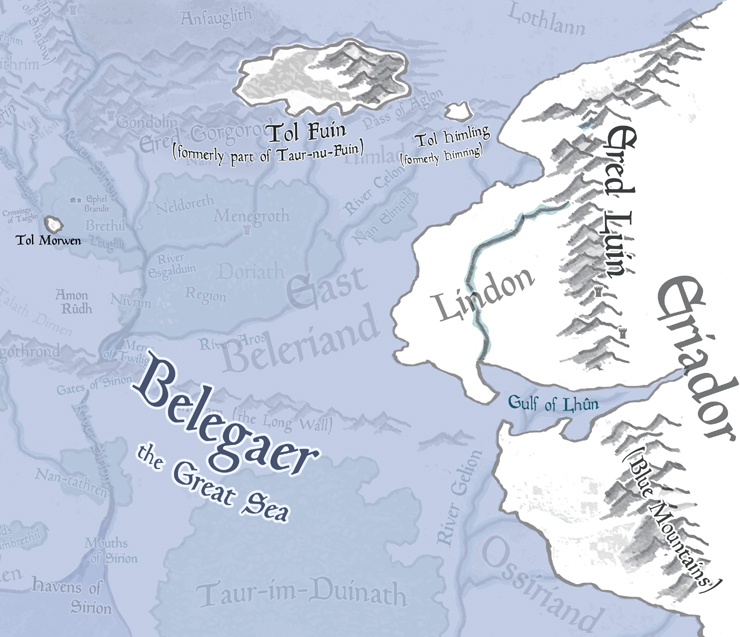
Oh, and speaking of the Blue Mountains, what happens to the Dwarves?! Well, while the Dwarves of Nogrod may have been greatly diminished by their ill-advised tussle with the Elves of Doriath (not to mention old Beren One-handed), they kept to themselves during the War of Wrath, as did those of the city of Belegost, for certain. But did those cities survive the shake-up? For that answer we actually have to look at the “Durin’s Folk” section of Appendix A in The Lord of the Rings:
At the end of the First Age the power and wealth of Khazad-dûm was much increased; for it was enriched by many people and much lore and craft when the ancient cities of Nogrod and Belegost in the Blue Mountains were ruined at the breaking of Thangorodrim.
So there we are. While both Dwarf cities get wrecked in the cataclysm, it seems like many and/or most of the Dwarves themselves were able to abandon them, go east, and seek their fortunes and their mines in Eriador and beyond.
Anyway, that’s for the land masses that remained. But what about islands? Well, in The Silmarillion itself, Tolkien only cites one at the end of Chapter 21, that place where Morwen and Túrin lie entombed (with Nienor merely memorialized):
and still Tol Morwen stands alone in the water beyond the new coasts that were made in the days of the wrath of the Valar.
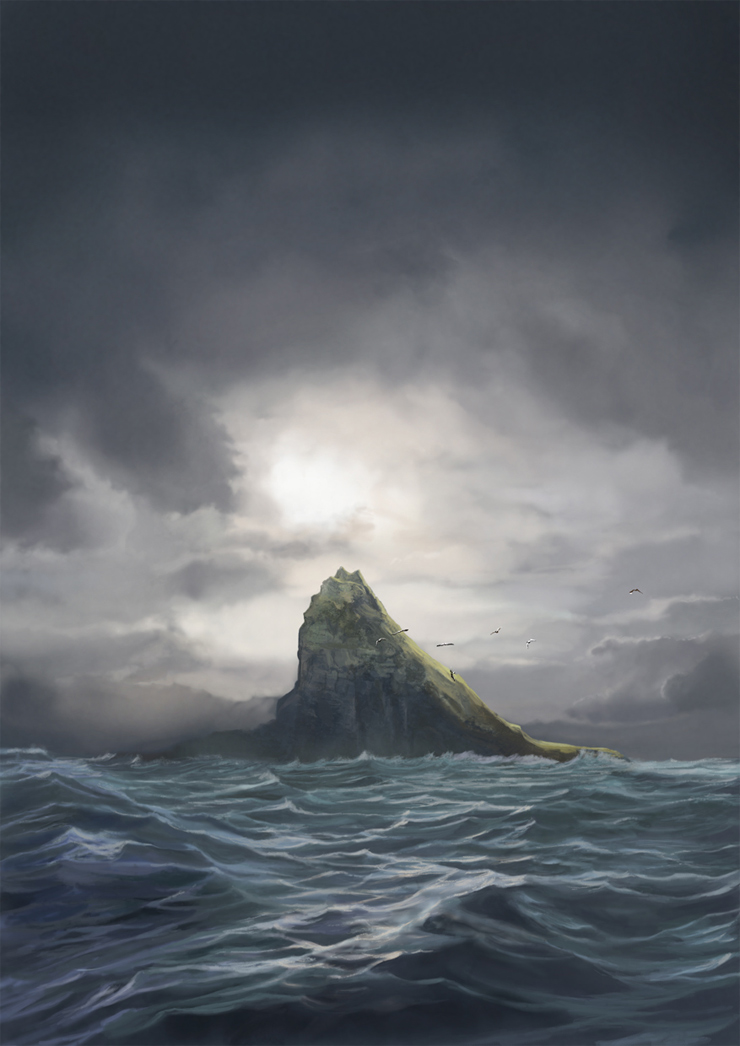
That said, Tolkien had two other parts of Beleriand in mind, cited in Unfinished Tales but not actually mentioned in the published Silmarillion. One is the hill of Himring, upon which Maedhros had built his fortress in the years of the leaguer of the Noldor. On the maps of Eriador in The Lord of the Rings, you can also see it there just off the northwestern coast, and it’s labeled Himling (which had been Tolkien’s earlier name for it). The other is only a little further to the west, and it’s a much greater stretch of land. It’s a part of what used to be Dorthonion, where Finarfin’s sons Angrod and Aegnor once ruled, and which later became Taur-nu-Fuin (the Forest under Nightshade) after the Battle of Sudden Flame. And now it’s just a larger island called Tol Fuin.
And so ends the First Age, with most of the remaining Elves having sailed west to Valinor.
Heyyy, what about Morgoth? Well, there’s a special place in the Void prepared for him, and that special place is everywhere and nowhere. He gets no cozy cell in Mandos Penitentiary this time, no three-age sentence and retrial. The Valar’s tolerance for him now is exactly zilch. Even Nienna, who once spoke in his defense, is basically, “See ya, wouldn’t wanna be ya!”
No one’s sorry to see him go.
He is “thrust” (or maybe frog-marched and drop-kicked by Tulkas?) out into the Timeless Void, a.k.a. the Everlasting Dark, the very non-place where he started. Don’t let the Door of Night beyond the Walls of the World hit you on the way out, Morgoth!
He is now outside Arda, and outside Eä, the Universe itself, and lacks the power he once had to slip back in. And Eärendil will keep eyes on the Door, just in case. Morgoth can’t hurt anyone in the Void because there is no one there. There’s nothing to create, no one to control, no thing to mar. There isn’t even a Flame Imperishable to seek (which got him in trouble in the first place) since that’s always been with Ilúvatar.
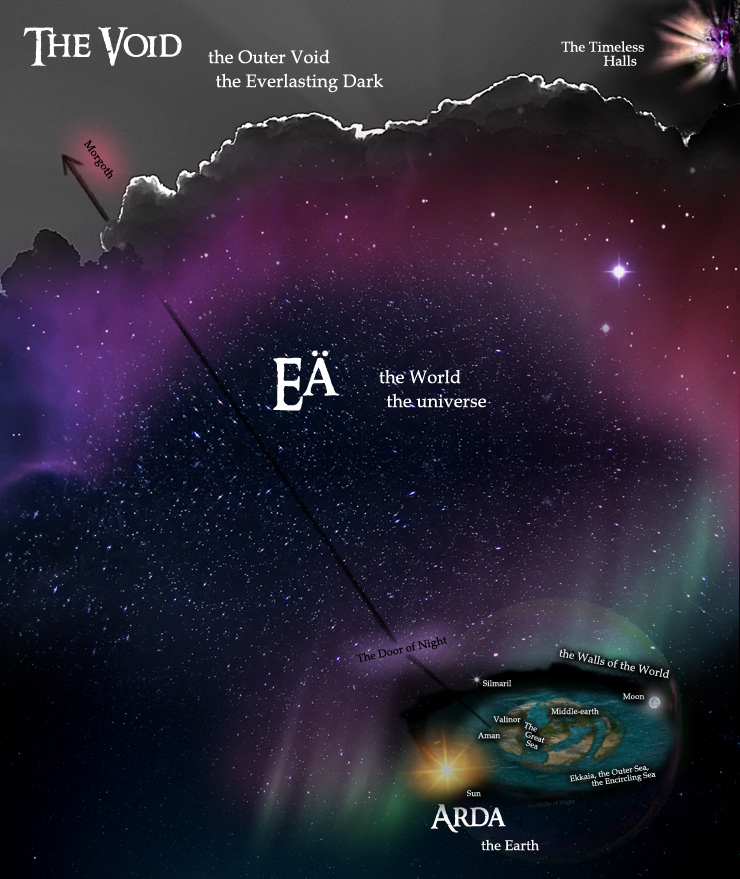
Morgoth faces utter unending boredom, I suppose you could say. He doesn’t even get a mirror in which to admire or loathe his own hideous, Eagle-scratched face. Boo-hoo.
But…Arda is still Arda Marred, and though he cannot micromanage his evil anymore, it does live on in the world without him. It’s in the hearts of Elves and Men (and Dwarves) still; moreover, it cannot be eliminated until such time as Ilúvatar has the world remade again. I suppose Morgoth could take these enduring stains of evil as some kind of consolation prize, but it’s not like he gets to witness and enjoy it.
So the Dark Lord is defeated! Long live the…second Dark Lord? That’s right, there’s no mention of what happens to Sauron just yet. But we know he’s still around and will be up to no good in due time. It seems to be in Tolkien’s nature to present information in dramatic rather than chronological order. But for Primer purposes, it’s helpful to know that Sauron isn’t simply grabbed up and tossed out into the Void like his boss. In fact, after Morgoth gets the boot, Sauron is seriously freaked out. While the surviving Balrogs buggered off, he willingly comes forth to apologize to Eönwë, seeking pardon. Hard to imagine the future Lord of Mordor doing even that much, isn’t it?
But granting pardon to one anyone, especially a peer of his own spiritual rank—a Maia, and a genocidal tyrant and slavemaster at that—is well above Eönwë’s pay grade. You don’t seek forgiveness from a fellow student if you deface school property and beat up a bunch of other kids…you face the principal. Eönwë tells Sauron he must go to Aman and face the judgment of Manwë, which means accepting humility. Say, do you think he’ll do it?
Well, that’s the end of the Tale of the Silmarils, but not the end of the book. If you found your first read-through to be challenging, know that you’re not the first.
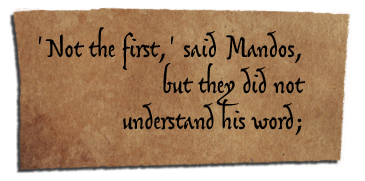
In the next Primer installment, we’ll take on the Akallabêth , a.k.a. the story of the rise and fall of Númenor, which also explains why the Dúnedain have so much mojo. But first, I’ll be offering a review of the new book, Tolkien: Maker of Middle-earth, the tie-in to the Bodleian Library’s current exhibit featuring the work and life of our favorite professor!
Top image from “The Dragon and the Star” by Manuel Castañón.
Jeff LaSala isn’t in to pro-wrestling or anything, but sure would love to see a WWE-style cage match of Tulkas vs. Morgoth play out properly, with ropes, improvised weapons, folding chairs, and all. Tolkien geekdom aside, Jeff wrote a Scribe Award–nominated D&D novel, produced some cyberpunk stories, and now works for Tor Books. He is sometimes on Twitter.










